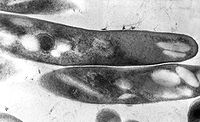
Photo from wikipedia
Mycobacterium pinnipedii, the known causative agent of tuberculosis (TB) in marine mammals, was only recognised as a member of the Mycobacterium tuberculosis complex in 2003 [1] and is believed to… Click to show full abstract
Mycobacterium pinnipedii, the known causative agent of tuberculosis (TB) in marine mammals, was only recognised as a member of the Mycobacterium tuberculosis complex in 2003 [1] and is believed to cause TB in several species, including nonmarine mammals [2, 3] and even humans [4]. The assumption of zoonotic transmission has been strongly reinforced by a disruptive study published in 2014 by a team of archaeologists from Tübingen, Germany [5]. Based on archaeological and genomic investigations on millennial human skeletons, the authors implicated sea mammals infected with M. pinnipedii as a source of New World human TB. Considering that this phenomenon pre-dates the human migrations to South America by several centuries, they refuted the previous scientific hypothesis of TB driven by human contact [6]. Use of culture isolation and whole-genome sequencing analysis to report the first confirmed case of animal-to-human transmission of Mycobacterium pinnipedii involving a sea lion and a keeper in a zoo https://bit.ly/3hEYu3s
Journal Title: European Respiratory Journal
Year Published: 2020
Link to full text (if available)
Share on Social Media: Sign Up to like & get
recommendations!